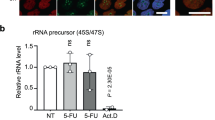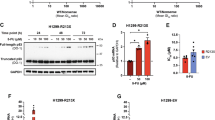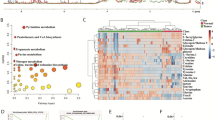Abstract
The relationship between uridine phosphorylase (UP) expression level in cancer cells and the tumour sensitivity to fluoropyrimidines is unclear. In this study, we found that UP overexpression by gene transfer, and the subsequent efficient metabolic activation of 5-fluorouracil (5-FU) by the ribonucleotide pathway, does not increase the fluoropyrimidine sensitivity of MCF-7 human cancer cells. © 2001 Cancer Research Campaign http://www.bjcancer.com
Similar content being viewed by others
Article PDF
Change history
16 November 2011
This paper was modified 12 months after initial publication to switch to Creative Commons licence terms, as noted at publication
References
Ackland SP and Peters GJ (1999) Thymidine phosphorylase: its role in sensitivity and resistance to anticancer drugs. Drug Resist Update 2: 205–214
Armstrong RD and Diasio RB (1980) Metabolism and biological activity of 5′-deoxy-5-fluorouridine, a novel fluoropyrimidine. Cancer Res 40: 3333–3338
Bradford MM (1976) A rapid and sensitive method for the quantitation of microgram quantities of protein utilising the principle of protein-dye binding. Anal Biochem 72: 248–254
Ciccolini J, Peillard L, Evrard A, Cuq P, Aubert C, Pèlegrin A, Formento P, Milano G and Catalin J (2000) Enhanced antitumor activity of 5-fluorouracil in combination with 2′-deoxinosine in human colorectal cell lines and human colon tumor xenografts. Clin Cancer Res 6: 1529–1535
Evrard A, Vian L, Aubert C and Cano JP (1996) An in vitro nucleoside analog screening method for cancer gene therapy. Cell Biol Toxicol 12: 345–350
Evrard A, Cuq P, Robert B, Vian L, Pèlegrin A and Cano JP (1999a) Enhancement of 5-fluorouracil cytotoxicity by human thymidine phosphorylase expression in cancer cells: in vitro and in vivo study. Int J Cancer 80: 465–470
Evrard A, Cuq P, Ciccolini J, Vian L and Cano JP (1999b) Increased cytotoxicity and bystander effect of 5-fluorouracil and 5-deoxy-5-fluorouridine in human colorectal cancer cells transfected with thymidine phosphorylase. Br J Cancer 80: 1726–1733
Haraguchi M, Furukawa T, Sumizawa T and Akiyama S (1993) Sensitivity of human KB cells expressing platelet-derived endithelial cell growth factor factor to pyrimidine antimetabolites. Cancer Res 53: 5680–5682
Ikemoto S, Sugimura K, Wada S, Yasumoto R, Yamamoto K and Kishimoto T (1999) Augmentation of antitumor activity of 5′-deoxy-5-fluorouridine by thymosin fraction 5 in mouse bladder cancer cells in vitro and in vivo. Cancer Lett 145: 121–126
Ishitsuka H, Miwa M, Takemoto K, Fukuoka K, Itoga A and Maruyama HB (1980) Role of uridine phosphorylase for antitumor activity of 5′-deoxy-5-fluorouridine. Jpn J Cancer Res 71: 112–123
Kanyama H, Tomita N, Yamano T, Miyoshi Y, Ohue M, Fujiwara Y, Sekimoto M, Sakita I, Tamaki Y and Monden M (1999) Enhancement of the anti-tumor effect of 5′-deoxy-5-fluorouridine by transfection of thymidine phosphorylase gene into human colon cancer cells. Jpn J Cancer Res 90: 454–459
Kato Y, Matsukawa S, Muraoka R and Tanigawa N (1997) Enhancement of drug sensitivity and a bystander effect in PC-9 cells transfected with a platelet-derived endothelial cell growth factor thymidine phosphorylase cDNA. Br J Cancer 75: 506–511
Koizumi W, Saigenji K, Nakamaru N, Okayasu I and Kurihara M (1999) Prediction of response to 5′-deoxy-5-fluorouridine (5′-DFUR) in patients with inoperable advanced gastric cancer by immunostaining of thymidine phosphorylase/platelet-derived endothelial cell growth factor. Oncology 56: 215–222
Kufe DW and Major PP (1981) 5-fluorouracil incorporation into human breast carcinoma RNA correlates with cytotoxicity. J Biol Chem 256: 9802–9805
Patterson AV, Zhang H, Moghaddam A, Bicknell R, Talbot DC, Straford IJ and Harris AL (1995) Increased sensitivity to the prodrug 5′-deoxy-5-fluorouridine and modulation of 5-fluoro-2′-desoxyuridine sensitivity in MCF-7 cells transfected with thymidine phosphorylase. Br J Cancer 72: 669–675
Peters GJ, Laurensse E, Leyva A, Lankelma J and Pinedo HM (1986) Sensitivity of human, murine, and rat cells to 5-fluorourcil and 5′-deoxy-5-fluorouridine in relation to drug-metabolizing enzymes. Cancer Res 46: 20–28
Saito H, Tsujitani S, Oka S, Kondo A, Ikeguchi M, Maeta M and Kaibara N (1999) The expression of thymidine phosphorylase correlates with angiogenesis and the efficacy of chemotherapy using fluorouracil derivatives in advanced gastric carcinoma. Br J Cancer 81: 484–489
Schwartz EL, Baptiste N, Wadler S and Makower D (1995) Thymidine phosphorylase mediates the sensitivity of human colon carcinoma cells to 5-fluorouracil. J Biol Chem 270: 19073–19077
Watanabe SI and Uchida T (1995) Cloning and expression of human uridine phosphorylase. Biochem Biophys Res Commun 216: 265–272
Watanabe SI, Hino A, Wada K, Eliason JF and Uchida T (1995) Purification, cloning, and expression of uridine phosphorylase. J Biol Chem 270: 12191–12196
Author information
Authors and Affiliations
Rights and permissions
From twelve months after its original publication, this work is licensed under the Creative Commons Attribution-NonCommercial-Share Alike 3.0 Unported License. To view a copy of this license, visit http://creativecommons.org/licenses/by-nc-sa/3.0/
About this article
Cite this article
Cuq, P., Rouquet, C., Evrard, A. et al. Fluoropyrimidine sensitivity of human MCF-7 breast cancer cells stably transfected with human uridine phosphorylase. Br J Cancer 84, 1677–1680 (2001). https://doi.org/10.1054/bjoc.2001.1833
Received:
Revised:
Accepted:
Published:
Issue date:
DOI: https://doi.org/10.1054/bjoc.2001.1833
Keywords
This article is cited by
-
Genetic factors influencing Pyrimidine-antagonist chemotherapy
The Pharmacogenomics Journal (2005)
-
Both gene expression for orotate phosphoribosyltransferase and its ratio to dihydropyrimidine dehydrogenase influence outcome following fluoropyrimidine-based chemotherapy for metastatic colorectal cancer
British Journal of Cancer (2003)
-
Role of platelet-derived endothelial cell growth factor/thymidine phosphorylase in fluoropyrimidine sensitivity
British Journal of Cancer (2003)



